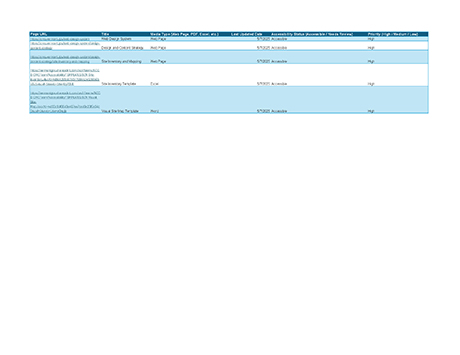Task 2: Inventory Content Used for Programs
By April 24, 2026, digital documents on state web platforms that are currently used to apply for, gain access to, or participate in the services, programs, or activities we offer must comply with the new digital accessibility rule under the ADA. The steps outlined below will help you identify the documents you will need to ensure are accessible, and prioritize repairs.
Step 1: Make a List of Public-Facing Webpages and Documents
Step 3: Organize Findings in a Spreadsheet
Step 4: Prioritize Based on Risk and Use
Step 1: Make a List of Public-Facing Webpages and Documents
Start with your highest-impact materials. Make a list of public-facing web pages and documents (e.g., grant programs, application portals, service descriptions).
Step 2: Gather Forms
For each program, identify online forms, guidance documents, applications, and policy summaries. Talk to your program staff to confirm which documents are still current and actively used.
Step 3: Organize Findings in a Spreadsheet
You can organize your findings in a spreadsheet with the following columns. Below is a link to an Excel template to get you started.
- Page URL
- Title
- Media Type (Web Page, PDF, Excel, etc.)
- Last Updated Date
- Accessibility Status (Accessible / Needs Review)
- Priority (High / Medium / Low. Definitions are provided in Step 4: Prioritize Based on Risk and Use.)
Inventory Priority Content for ADA Compliance Template
This template includes one worksheet with only five columns to help you inventory both webpages and documents.

Step 4: Prioritize Based on Risk and Use
Sort your inventory based on the "Priority" column. Below are definitions of the High, Medium, and Low priority levels.
High Priority
- Forms or documents that are currently needed to apply for a benefit or participate in a program.
- Program information tied to deadlines or public funding.
Medium Priority
- Guidance documents or policy references still in use but not pointed to.
Low Priority
- Old reports or inactive program materials.
Next up!
You can get a head start by fixing your high-priority documents. Use tools like the Adobe Acrobat Pro Accessibility Checker to test and remediate PDF documents, or transition the document in its entirety to one layouts featured in the Chief Marketing Office's Template Resources.
